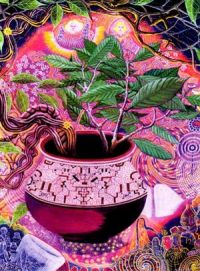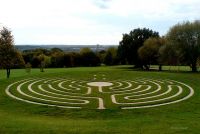The New York Times reviews "I'm Dangerous With Love", a documentary about Dmitri Mugianis, who beats his heroin addiction with an old school, Gabon Ibogaine treatment. Mr. Mugianis, who in clips from his drug-addicted days fronting a rock band looks as if he could have easily ended up in a morgue, credits ibogaine with saving his life, and he is nothing if not sincere. “I’m so glad to have gray hair,” he says, tearing up. “I’m so glad to be going bald. I’m so glad to be able to wear reading glasses.” Soon to be in a Netflix queue near you...
 |
Can police kick down your door without a search warrant because they "think" they smell marijuana? That is an issue for the Supreme Court. From the Washington Post:
Kentucky police were following a man who had just sold drugs to an undercover informant. They entered an apartment breezeway, heard a door slam and found they had two choices.
Behind door No. 1 was the dealer. And, unfortunately for him, behind door No. 2 were Hollis King and friends, smoking marijuana.
Smelling the drug, the officers banged loudly on King's apartment door and identified themselves as police. The officers said they heard a noise and feared evidence was being destroyed. They kicked down the door and found King, two friends, some drugs and cash.
King was sentenced to 11 years in prison, but the Kentucky Supreme Court overturned his conviction. It said that the officers had entered the apartment illegally and that the evidence they found should not have been considered in court.
On Wednesday, the case made its way to the U.S. Supreme Court, where it will provide another chance for justices to decide when police may enter a home without permission or a warrant and not violate the Constitution's protections against unreasonable searches.
 Oxytocin: The 'Love Hormone'
Ocytocin's Dark Side, from NYTimes:
Oxytocin has been described as the hormone of love. This tiny chemical, released from the hypothalamus region of the brain, gives rat mothers the urge to nurse their pups, keeps male prairie voles monogamous and, even more remarkable, makes people trust each other more.
Yes, you knew there had to be a catch. As oxytocin comes into sharper focus, its social radius of action turns out to have definite limits. The love and trust it promotes are not toward the world in general, just toward a person’s in-group. Oxytocin turns out to be the hormone of the clan, not of universal brotherhood. Psychologists trying to specify its role have now concluded it is the agent of ethnocentrism...
Despite the limitation on oxytocin’s social reach, its effect seems to be achieved more through inducing feelings of loyalty to the in-group than by fomenting hatred of the out-group. The Dutch researchers found some evidence that it enhances negative feelings, but this was not conclusive. “Oxytocin creates intergroup bias primarily because it motivates in-group favoritism and because it motivates out-group derogation,” they write.
Plus another little snip on the same research from PhysOrg:
In future research, Dr. De Dreu and colleagues plan to investigate any links between oxytocin and social behaviors that may have evolutionary significance, such as cooperation, penalizing deviation from accepted behaviors, and behaviors associated with religious experience. Dr. De Dreu expects oxytocin will be found to have no more effect on religious experience than other behaviors such as soccer hooliganism, and said that when people join with others who share their values, this “drives up the level of oxytocin.”
[Thanks Sam Hell!]
 |
Of course they still get it wrong and title the article, "Acid Trip: In search of the Amazon's magical mystery cure". People are still searching for the magical mystery cure? Acid in the Amazon? Oh well, at least they're trying.
AFTER STEVE WITTE was laid off from his job at Pfizer last year, he decided to pursue a radically different approach to medicine. Swapping his New York apartment for a thatch hut near Iquitos, Peru, Witte, 44, set aside his squash hobby to become an apprentice under the master shaman Alfredo Cairuna.
Like many of the traditional healers in this part of the Amazon, Cairuna -- who is of the indigenous Shipibo people -- serves as an intermediary between the physical and spiritual worlds, with the help of a hallucinogen known as ayahuasca, a plant-based concoction that has been used for centuries to treat a range of physical and spiritual maladies. Tourists, equally convinced that ayahuasca can alleviate everything from chronic pain to depression, have more recently turned its distribution into a thriving local industry. People "go back to work more calm and accepting -- or they make huge decisions they weren't able to before," Witte says of those who come to visit Cairuna's ayahuasca lodge. "People say it changes their lives."
Served as a drink by Cairuna during an elaborate ceremony that lasts for hours, ayahuasca is made mainly of the local ayahuasca and chacruna plants. It is thick and muddy and the color of clay. Drinking it usually occasions some intense vomiting, but that's hardly the most extreme side effect. "It can be painful, and you can suffer, but it can also be intensely beautiful and enlightening beyond words. It can be a cleansing of your body in every way. I've seen people get really scared," says Witte. "I just try to keep a calm mind, even if strange things happen.

A new application for the iPhone, the XWave, lets you read your own mind via a headset clamped to your head and connected to the phone’s audio jack.
The plastic headband, which costs around $100, has a sensor that presses against the user’s forehead and communicates with a free XWave iPhone application that then shows your brain waves graphically on the iPhone screen. As you focus your mind on a task the graphics are changed -- a ball may move higher for instance, or your state of relaxation may be indicated by changes in a pulsating color, which moves towards blue as you become more relaxed.
Brainwave detection is powered by an NeuroSky eSense dry sensor, which provides a brain-computer interface (BCI) to sense even faint electrical impulses in the brain and convert them to digital signals that are sent to the iPhone. Previous applications of the NeuroSky technology include computer games and toys. In XWave an algorithm is applied to the brain rhythms to convert them to graphical representations of attention and meditation values.
Not sure how well the headset works, but the little brainwave interface for the iPhone sure looks cool.
Tickets for Breaking Convention: A Multidisciplinary Conference on Psychedelic Consciousness are now on sale and can be bought from the conference’s website. Earlybird tickets are priced at £40 for students & concessions and £60 for general admission.
Breaking Convention: A Multidisciplinary Conference on Psychedelic Consciousness is being held at the University of Kent in Canterbury, England, between the 2nd and 3rd of April, 2011. The conference will be centred around four symposia discussing: 1) Current research on consciousness and psychedelics at the University of Kent; 2) Ecstasy - Its place in medicine, society and politics: A multidisciplinary debate of the relative benefits and risks of MDMA; 3) What Does Psychedelic Mean? Organised by PsypressUK friend and contributor Dr. David Luke, and 4) Bold Visions - The Future of Psychedelic Research, organised by our friends at the UKC Psychedelics Society.
 |
Originally published in 1999 under the title 'Forest of Visions: Ayahuasca, Amazonian spirituality, and the Santo Daime Tradition'; this edition, published under the new title 'The Religion of Ayahuasca: The Teachings of the Church of Santo Daime', came out in 2010. The author, Alex Polari De Alverga, tells the story of his own experiences with Santo Daime, alongside the history, and his relationship with, one of its leading members Sebastiao Mota de Melo.
Santo Daime was first founded by Mestre (Master) Irineu Serra in Brazil on March 26th 1931. The church "combines the inheritance of the Christian esoteric tradition with the spiritual legacy and indigenous force of the pre-Colombian people" and centres around a sacrament; the hallucinogenic brew ayahuasca. Mestre Irineu began the process of turning the "new knowledge" garnered from the spiritually structured framework of Santo Daime's ayahuasca relationship into doctrinal form, but after his death on July 6th 1971, it was left to his disciples to carry on the work.

A special event, called High Society – Drugs in Victorian Britain, is being put on to support the Wellcome Collection’s latest exhibition High Society , which is on in London till February 27th, 2011 (and, having visited this past week, is well worth the trip.) High Society – Drugs in Victorian Britain will take place on February 11th and 12th, 2011.
The event will open with a Friday evening of traditional Victorian entertainment including a performance of the extraordinary Magic Lantern, which fascinated 19th century audiences. On the Saturday a host of experts, writers and historians; including Mike Jay, the curator of High Society, Stuart Anderson, Associate Dean at the London School of Hygiene and Tropical Medicine, and historians Louise Foxcroft and Michael Neve will talk on a variety of aspects of Victorian drug culture.
Going around the interwebs, via Cute Overload. Seriously, what's in the grass dude?
[Thanks Sam Hell!]
 |
Drug-sniffing dogs can give police probable cause to root through cars by the roadside, but state data show the dogs have been wrong more often than they have been right about whether vehicles contain drugs or paraphernalia.
The dogs are trained to dig or sit when they smell drugs, which triggers automobile searches. But a Tribune analysis of three years of data for suburban departments found that only 44 percent of those alerts by the dogs led to the discovery of drugs or paraphernalia.
For Hispanic drivers, the success rate was just 27 percent.
Dog-handling officers and trainers argue the canine teams' accuracy shouldn't be measured in the number of alerts that turn up drugs. They said the scent of drugs or paraphernalia can linger in a car after drugs are used or sold, and the dogs' noses are so sensitive they can pick up residue from drugs that can no longer be found in a car.
But even advocates for the use of drug-sniffing dogs agree with experts who say many dog-and-officer teams are poorly trained and prone to false alerts that lead to unjustified searches. Leading a dog around a car too many times or spending too long examining a vehicle, for example, can cause a dog to give a signal for drugs where there are none, experts said.
"If you don't train, you can't be confident in your dog," said Alex Rothacker, a trainer who works with dozens of local drug-sniffing dogs. "A lot of dogs don't train. A lot of dogs aren't good."
The dog teams are not held to any statutory standard of performance in Illinois or most other states, experts and dog handlers said, though private groups offer certification for the canines.
Dogs are certainly good at smelling the presence of specific items, but it also seems like they can be easily trained to create probable cause where it doesn't exist. There is no oversight for corrupt police dogs.
[Thanks Sam Hell!]
|

Recently @ DoseNation
|
|



















